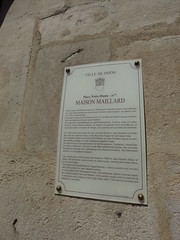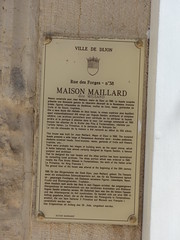Commemorated on 2 plaques
Place Notre-Dame - no 7 Maison Maillard Cette maison fut élevée à partir de 1565 par le victomte-mayeur Jean Maillard qui avait déjà entrepris la construction de son autre maison, du même nom, au no 38 rue des Forges. La façade a peut-être été réalisée selon un modèle de l'artiste Hugues Sambin, qui avait déjà œuvré por Jean Maillard. Son décor est caractéristique du style Renaissance : frontons, têtes et mufles de lions, fruits et fleurs sculptés. Au centre, une grande niche dominée par un cartouche abrite une statue de Vierge. Les lucarnes sont accotées de cariatides.
English translation: Place Notre-Dame - no 7 House Maillard This house was raised from 1565 by Jean Maillard, mayor of Dijon. Who had already begun the construction of his other house of the same name at No. 38 rue des Forges. The facade may have been made according to a model of the artist Hugues Sambin, who had already worked for Jean Maillard. Its decoration is characteristic of the Renaissance style: pediments, heads and muzzles of lions, fruits and carved flowers. In the center, a large niche dominated by a cartridge houses a statue of the Virgin. The dormers are crowned with caryatids.
7 Place Notre Dame, Dijon, France where they owned
Rue des Forges - no 38 Maison Maillard dite Milsand Maison construite pour Jean Maillard, maire de Dijon en 1560. La façade sculptée présente une étonnante gamme du répertoire décoratif de la Renaissance: frontons brisés, figures rehaussés de diadèmes, mufles de lions, vases, guirlandes de fruits et de fleurs, trophées... Elle a sans doute été réalisée en deux temps, le niveau supérieur plus équilibré ayant vraisemblablement été conç u par Hugues Sambin, architecte et sculpteur célèbre. Les archives permettent avec certitude de lui attribuer la façade arrière et le portique à atlantes dans la cour. Cet ouvrage commandé en 1565 évoque les atlantes de la Grotte des Pins à Fontainebleau, réalisée par l'artiste italien, La Primatice, à la demande de François 1er. Le rez-de-chaussée de la maison a été remanié au début du 20ème siècle.
English translation: Rue des Forges - no 38 Maison Maillard dite Milsand This house was built for Jean Maillard. Mayor of Dijon in 1560. The sculpted facade presents a wide range of Renaissance decorative word : brocken pediments, diadems-crowned heads, lion-muzzles, vases, garlands of fruits and flowers, trophies, etc ... There were probably two stages of building work, as the upper storey, which is better balanced, was almost certainly designed by Hugues Sambin, a famous sculptor and architect. That he designed the rear facade and the Atlas portico has benn ascertained by consulting local archives. The Atlas portico which was ordered in 1565 recalls the Pine Grotto Atlases in Fontainebleau, the work of the Italian artist La Primatice, for King Francois 1. The ground floor of the house was altered at the beginning of the 20th century.
38 Rue des Forges, Dijon, France where they owned


